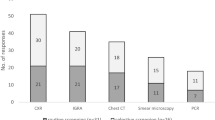Abstract
Latent tuberculosis infection (LTBI) remains a problem in the United States as reactivation leads to active TB disease particularly in persons with risk factors. The objective of this study is to assess the knowledge, attitudes and health behaviors related to testing and treatment of LTBI among non-US-born South Asians (SA) in New Jersey (NJ). A cross-sectional, community-based survey was the primary tool for gathering data. Eligibility criteria included being at least 18 years of age, self-identifying as SA, verbal consent for participation, and birth in a high TB endemic country. A hardcopy survey was distributed at local South Asian health fairs. The survey included questions about demographics, knowledge, beliefs on TB, and health behaviors (testing and treatment). Descriptive statistics were performed for all survey responses. Logistic regression models were constructed to assess the association of characteristics/beliefs and study outcomes. The survey sample size included 387 respondents. A total of 197 (54%) of respondents reported ever been tested for TB. Those who were tested for TB were generally younger, had higher educational levels, higher household incomes, and were more likely to have health insurance than those not ever tested for TB. Significantly more respondents who self-reported ever been tested for TB believed that TB was very or extremely serious (71.1% vs. 56.2%, p = 0.004). Also, significantly more respondents who self-reported ever been tested for TB believed that it was important to get tested (91.2% vs. 63.3%, p < 0.001). The survey analysis concluded that high-risk SA residents in NJ demonstrated a low rate of testing for TB.
Similar content being viewed by others
References
Tackling Poverty. (2005). Tuberculosis control. Lancet, 366(9503), 2063.
Oxlade, O., & Murray, M. (2012). Tuberculosis and poverty: Why are the poor at greater risk in India? PLoS One, 7(11), e47533.
Global Tuberculosis Report. (2018). Geneva: World Health Organization.
Bloom, B. R. A. (2018). Neglected epidemic. New England Journal of Medicine, 378(3), 291–293.
Force, U.S.P.S.T., Bibbins-Domingo, K., Grossman, D. C., Curry, S. J., Bauman, L., Davidson, K. W., et al. (2016). Screening for latent tuberculosis infection in adults: US preventive services task force recommendation statement. JAMA, 316(9), 962–969.
World Health Organization. (2018). Latent tuberculosis infection: Updated and consolidated guidelines for programmatic management. Geneva: World Health Organization.
Getahun, H., Matteelli, A., Chaisson, R. E., & Raviglione, M. (2015). Latent Mycobacterium tuberculosis infection. New England Journal of Medicine, 372(22), 2127–2135.
Houben, R. M., & Dodd, P. J. (2016). The global burden of latent tuberculosis infection: A re-estimation using mathematical modelling. PLoS Medicine, 13(10), e1002152.
Shea, K. M., Kammerer, J. S., Winston, C. A., Navin, T. R., & Horsburgh, C. R. (2014). Estimated rate of reactivation of latent tuberculosis infection in the United States, overall and by population subgroup. American Journal Epidemiology, 179(2), 216–225.
Mancuso, J. D., Diffenderfer, J. M., Ghassemieh, B. J., Horne, D. J., & Kao, T. C. (2016). The prevalence of latent tuberculosis infection in the United States. American Journal Respiration of Critical Care Medicine, 194(4), 501–509.
Stewart, R. J., Tsang, C. A., Pratt, R. H., Price, S. F., & Langer, A. J. (2018). Tuberculosis—United States, 2017. MMWR Morbility Mortal Weekly Reports, 67(11), 317–323.
Stennis, N., Trieu, L., Perri, B., Anderson, J., Mushtaq, M., & Ahuja, S. (2015). Disparities in tuberculosis burden among South Asians living in New York City, 2001–2010. American Journal Public Health, 105(5), 922–929.
Davidow, A. L., Mangura, B. T., Napolitano, E. C., & Reichman, L. B. (2003). Rethinking the socioeconomics and geography of tuberculosis among foreign-born residents of New Jersey, 1994–1999. American Journal Public Health, 93(6), 1007–1012.
Asghar, R. J., Pratt, R. H., Kammerer, J. S., & Navin, T. R. (2008). Tuberculosis in South Asians living in the United States, 1993–2004. Archives of Internal Medicine, 168(9), 936–942.
Alsdurf, H., Hill, P. C., Matteelli, A., Getahun, H., & Menzies, D. (2016). The cascade of care in diagnosis and treatment of latent tuberculosis infection: A systematic review and meta-analysis. Lancet Infectious Disease, 16(11), 1269–1278.
Bacaner, N., Stauffer, B., Boulware, D. R., Walker, P. F., & Keystone, J. S. (2004). Travel medicine considerations for North American immigrants visiting friends and relatives. JAMA, 291(23), 2856–2864.
Schmit, K. M., Wansaula, Z., Pratt, R., Price, S. F., & Langer, A. J. (2017). Tuberculosis—United States, 2016. MMWR Morbidity Mortality Weekly Report, 66(11), 289–294.
Munro, S., Lewin, S., Swart, T., & Volmink, J. (2007). A review of health behaviour theories: How useful are these for developing interventions to promote long-term medication adherence for TB and HIV/AIDS? BMC Public Health, 7, 104.
Pai, M., & Rodrigues, C. (2015). Management of latent tuberculosis infection: An evidence-based approach. Lung India, 32(3), 205–207.
Nasreen, S., Shokoohi, M., & Malvankar-Mehta, M. S. (2016). Prevalence of latent tuberculosis among health care workers in high burden countries: A systematic review and meta-analysis. PLoS One, 11(10), e0164034.
Acknowledgements
We would like to acknowledge the support of the Middlesex County Department of Health, the students and personnel of the South Asian Total Health Initiative (SATHI) at Rutgers, The University of New Jersey and St. Peter’s University Hospital, and Dr. Elizabeth Marshall from Rutgers School of Public Health.
Author information
Authors and Affiliations
Corresponding author
Ethics declarations
Conflict of interest
The authors have no conflicts of interest to report relevant to this publication.
Additional information
Publisher’s Note
Springer Nature remains neutral with regard to jurisdictional claims in published maps and institutional affiliations.
Rights and permissions
About this article
Cite this article
Narayanan, N., Gulati, N., Ghoshal, B. et al. Latent Tuberculosis Infection Beliefs and Testing and Treatment Health Behaviors Amongst Non-US-Born South Asians in New Jersey: A Cross-Sectional Community Survey. J Community Health 44, 796–804 (2019). https://doi.org/10.1007/s10900-018-00607-4
Published:
Issue Date:
DOI: https://doi.org/10.1007/s10900-018-00607-4




